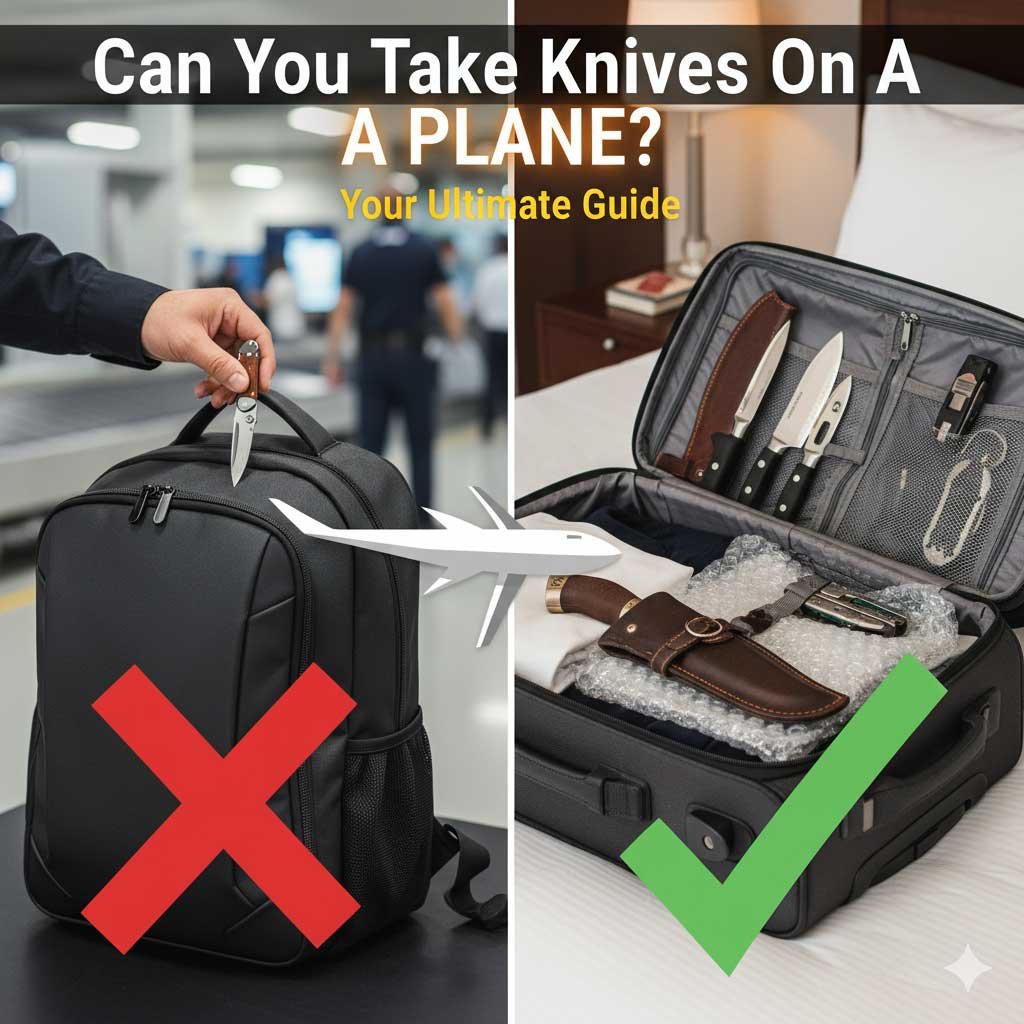Preparing for a trip often means juggling packing lists, ticketing details, and endless questions about what’s allowed past the security checkpoint. One of the most common and confusing items travelers ask about is a knife. Whether it’s your trusty pocket knife, an expensive chef’s knife for a cooking retreat, or even a souvenir utility knife, the question remains: Can you take knives on a plane?
The short answer is: It depends entirely on where you pack it. You will almost certainly face issues if you try to bring any sharp object, especially a metal knife, in your carry-on baggage. However, most types of knives are perfectly fine to travel with if you place them securely in your checked baggage. This comprehensive guide will slice through the confusion and give you all the information you need to travel safely and without drama.

Table of Contents
Why Knife Rules are So Strict?
The rules around carrying sharp objects on an airplane are not meant to inconvenience you; they are in place for the safety and security of all passengers and crew. Following the events of 9/11, aviation security bodies worldwide, like the Transportation Security Administration (TSA) in the United States, adopted a zero-tolerance policy for items that could be used as a weapon in the cabin.
A knife, regardless of its intended use (camping, cooking, or general utility), falls under the category of sharp objects or edged weapons. Even a small blade can be considered a threat once past the security screening. Understanding this core reason—cabin safety—makes navigating the rules much clearer.
Carry-On Baggage: The Golden Rule for Knives
Let’s get straight to the point: Do not pack metal knives in your carry-on bag. This is the single most important rule to remember. Security officers are trained to spot sharp items, and attempting to pass one through the checkpoint will, at best, result in a significant delay and the confiscation of your item. At worst, it could lead to further screening and questioning.
What is Absolutely Prohibited in Your Carry-On?
- Any metal knife of any length. This includes hunting knives, kitchen knives, pocket knives, Swiss Army knives (even the small ones), box cutters, and utility knives.
- Throwing stars and similar martial arts equipment.
- Ice picks and similar sharp, pointed tools.
- Metal scissors with a pointed tip and blades exceeding a certain length (the TSA generally allows blunt-tipped scissors or those with blades less than 4 inches, but rules can vary, so it’s best to avoid them).
Exceptions: The Tiny Window of Permitted Blades
While nearly all metal knives are banned from the cabin, a few non-threatening, blunt-edged items are typically permitted. These are:
- Plastic cutlery: A plastic butter knife or fork is usually fine.
- Rounded-blade butter knives: Knives with no serration or sharp point, designed specifically for spreading.
- Disposable/Safety Razors: The blades must be contained within a plastic cartridge. Straight razors are prohibited.
Always remember: The final decision on whether an item is allowed rests with the screening officer at the checkpoint. If they feel an item poses a threat, they have the authority to prohibit it, even if it falls under a general exception.
Checked Baggage: Your Knife’s Travel Home
If you absolutely must travel with a knife, your checked baggage is the correct and only place for it. When you pack sharp items in your checked luggage, you are isolating them from the main cabin, effectively removing the security risk during the flight.
How to Pack Knives Safely in Checked Luggage
Packing your travel gear or kitchen items correctly is important. This step is about protecting the baggage handlers and inspectors who will be sifting through luggage, as well as protecting your own belongings.
- Sheathe or Wrap Securely: All sharp objects, especially kitchen knives or large hunting knives, must be properly sheathed. If you don’t have a hard sheath, wrap the blade securely in several layers of thick material, like heavy cardboard, bubble wrap, or a towel. The goal is to make it impossible for the sharp edge to cut through the wrapping.
- Separate and Isolate: Place the wrapped knife away from the sides of the suitcase. Nestling it among soft clothes or inside a durable container within the luggage can help prevent it from moving or being detected as easily upon initial visual inspection.
- Use Durable Luggage: Ensure your checked bag is sturdy and can withstand the rigors of baggage handling.
Pro-Tip for Enthusiasts: If you are traveling with a high-value item, such as a collector’s survival knife or a whole chef’s knife roll, consider using a lockable, hard-sided case inside your checked luggage for maximum protection and security.
International Travel: The Global Layer of Rules
Traveling domestically can be complex, but crossing borders introduces a whole new level of rules. Knife possession laws vary drastically from one country to the next. What is legal in your home country might be illegal or highly restricted in your destination.
Aspect | Domestic Travel (e.g., USA) | International Travel |
Authority | Governed by Aviation Security Agency (e.g., TSA, CATSA) | Governed by multiple countries’ laws + airline policy |
Carry-On Rule | Strictly prohibited (almost all blades) | Strictly prohibited (often includes a blade-length limit) |
Checked Rule | Permitted, but must be safely wrapped | Permitted in most cases, but local laws are key |
Key Concern | Airport security & in-flight safety | Airport security and legal possession upon entry |
Before your international flight:
- Research Destination Laws: Look up the knife laws for your destination and any layover countries. Some places have strict rules on blade length, locking mechanisms (e.g., switchblades), or whether a knife can be carried in public. Ignorance of the law is not an excuse.
- Consult Your Airline: While security agencies like the TSA set the baseline, airlines sometimes have their own, more restrictive prohibited items lists. A quick check on the airline’s website can save a lot of hassle.
Avoid International Knife Surprises: If a knife is not absolutely necessary for your trip, consider leaving it at home or purchasing a cheap one at your destination. This avoids any customs complications or legal misunderstandings.
Common Types of Knives and Their Travel Status
To help you quickly determine your item’s fate, here is a breakdown of common types of sharp objects:
Knife Type | Carry-On Baggage (Cabin) | Checked Baggage (Hold) | Important Notes |
Pocket Knife / Multi-Tool | NO. Prohibited. | YES. Must be sheathed/securely wrapped. | Even small key-chain models are typically banned from the cabin. |
Chef’s Knife / Kitchen Knife | NO. Prohibited. | YES. Wrap the blade thoroughly to prevent injury. | Essential for traveling chefs or culinary students. |
Box Cutter / Utility Knife | NO. Prohibited. | YES. Securely pack both the handle and any spare blades. | Considered a high-risk security item in the cabin. |
Hunting Knife / Survival Knife | NO. Prohibited. | YES. Secure in a hard sheath inside the checked bag. | High-value items should be declared to the check-in agent. |
Plastic Knife / Butter Knife (Rounded) | YES. Generally permitted. | YES. | Must be clearly plastic or have a rounded, blunt, non-serrated edge. |
Corkscrew with a Blade | NO. Prohibited due to the small blade. | YES. | You can often find corkscrews without a blade which are allowed in carry-on. |
Real-Life Traveler Scenarios: What Happens Next?
Let’s walk through what you might experience at the airport:
Scenario 1: The Accidental Pocket Knife
You forgot your favorite knife was clipped to the inside of your backpack.
What happens: When your carry-on bag goes through the X-ray machine, the blade will be flagged by the security system. A screening officer will call you over and ask you to open your bag. Once the knife is located, you will be told it is a prohibited item.
Your options:
- Place it in your checked bag: If you are still at the check-in area and have time, you can ask to retrieve your checked luggage to add the item.
- Mail it home: Some large airports offer a mail-back service, which usually involves a fee.
- Surrender it: You will have to surrender the item to the security officer, and it will be permanently confiscated. This is the most common outcome.
Scenario 2: Traveling with Professional Gear
You are a professional chef traveling to a competition with a locked case of culinary tools.
What happens: Since you’ve followed the rules and placed the knives securely in your checked luggage, they will travel safely in the hold. If the security team has questions, they may open your bag for inspection. They will usually leave a “Notice of Inspection” tag inside your luggage. As long as the items are properly declared and secured, they will continue on their journey.
Avoid Travel Headaches: Your Knife Checklist
Before you head to the airport, use this simple checklist to ensure a smooth journey with your sharp items:
- Is it essential? If not, leave the travel gear at home.
- Is it in my carry-on? If the answer is yes and it’s a metal blade, move it immediately.
- Is it in checked baggage? If yes, proceed to the next step.
- Is it safe? Is the blade sheathed or securely wrapped to prevent injury?
- Do I know the local laws? For international trips, have I researched the destination country’s knife possession laws?
By adhering to these strict, yet sensible, guidelines, you can ensure that your airport experience is hassle-free and that you don’t lose a valuable or sentimental item at the security checkpoint.
FAQ
No. All standard Swiss Army Knives contain a blade, which is a prohibited item in both domestic and international carry-on baggage. They must be packed safely in your checked luggage.
Yes, you can. Safety razors and disposable razors with the blade permanently enclosed in a plastic head are allowed in your carry-on. Straight razors and razor blades not in a cartridge must be placed in checked bags.
The knife will be detected at the security checkpoint. A security officer will call you to the screening area and give you the option to surrender the item, put it in checked baggage (if time allows), or mail it back to yourself (if the airport offers that service). Confiscation is the most common result.
To an aviation security officer, yes. Even the smallest key-chain knife or multi-tool with a miniature blade is considered a sharp object and is generally prohibited from the aircraft cabin.
No. Although ceramic, these knives still have an edge and a point that could pose a threat. They fall under the same rules as metal knives and must be packed in checked baggage and wrapped securely.
While you don’t typically need to verbally declare a regular kitchen or pocket knife in your checked bag to the airline, it’s wise to inform the check-in agent if you are traveling with high-value items like firearms or large hunting knives that require special handling, though standard knives usually do not.
No. Multi-tools like a Leatherman or Gerber nearly always contain a locking blade, scissors, or a saw, all of which are prohibited items in your carry-on luggage and must be placed in a checked bag.
Conclusion
Navigating airport security with sharp objects requires diligence and a clear understanding of aviation rules. The definitive answer to Can you take knives on a plane? is that you cannot take them in your carry-on bag, but you absolutely can and should pack them properly in your checked baggage. By respecting the strict rules for cabin safety and securely wrapping your travel gear and culinary instruments, you will ensure a smooth journey, keep your valuable possessions, and avoid unwanted delays at the security checkpoint.


